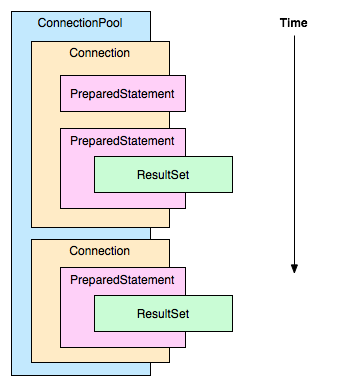Toolkit
Before we get into writing doobie programs it’s worth spending a moment to explain the big picture. The short explanation is:
doobie programs are values. You can compose small programs to build larger programs. Once you have constructed a program you wish to run, you interpret it into an effectful target monad of your choice (
IOfor example) and drop it into your main application wherever you like.
If you want a slightly longer explanation in video form, you might enjoy this lecture from Scala by the Bay 2015.
Nested Programs
doobie is a monadic API that provides a number of data types that all work the same way but describe computations in different contexts. For example ConnectionIO describes computations that take place in a context where a java.sql.Connection is available. Similar data types exist for each major type in java.sql. Programs written in these contexts compose naturally via lifting, mirroring the lifecycles of each contexts’s carrier type.

Some patterns of composition are so common and generic that they can be provided for you, as doobie does with its high-level API. As a result many programs can be written entirely in terms of ConnectionIO. Some examples are:
- Performing a query and reading the results as a stream.
- Performing an update and returning updated rows as a stream.
- Validating a query or update in terms of the schema and JDBC ⟷ Scala type mappings.
This book largely focuses on these common interactions, but also explains their representation at lower levels in case you wish to do something other than what you get for free.
Low and High level APIs
doobie provides two APIs intended for different audiences.
The low-level API in doobie.free provides a direct 1:1 mapping to the underlying JDBC API, giving library implementors a pure functional wrapper for the full JDBC 4.0 API. This API provides no resource safety, NULL checking, or type mapping; and it directly exposes lifetime-managed JDBC objects; programs written at this level have desirable compositional properties but still require a great deal of care. For example, doobie.free.FC contains the low-level API for JDBC Connection, and doobie.free.FPS contains the low-level API for PreparedStatement. (The “F” in the alias stands for “Free”)
The high-level API in doobie.hi (implemented entirely in terms of the low-level API) provides a safe subset of the JDBC API. Programs written with this API have no access to the underlying JDBC objects and cannot leak references. Features of this API include:
- Typeclass-based mapping of scalar, array, and vendor-specific types to columns.
- Typeclass-based mapping of product types to rows.
- Trivial custom two-way row/column mapping via invariant functors.
- Nullability via
Option(SQLNULLcannot be observed). - Proper enumerated types for all JDBC constants.
- Result sets as fs2 streams.
- Typesafe string interpolator for SQL literals.
The types used for both APIs are identical; the difference lies only in the exposed constructors. This means that a program otherwise written in the doobie.hi API can use constructors from doobie.free to implement advanced or vendor-specific behavior directly, without translation or lifting. Some examples of high-level APIs are doobie.hi.HC for JDBC Connection as well as doobie.hi.HPS for PreparedStatement. (The “H” in the alias stands for “High”)